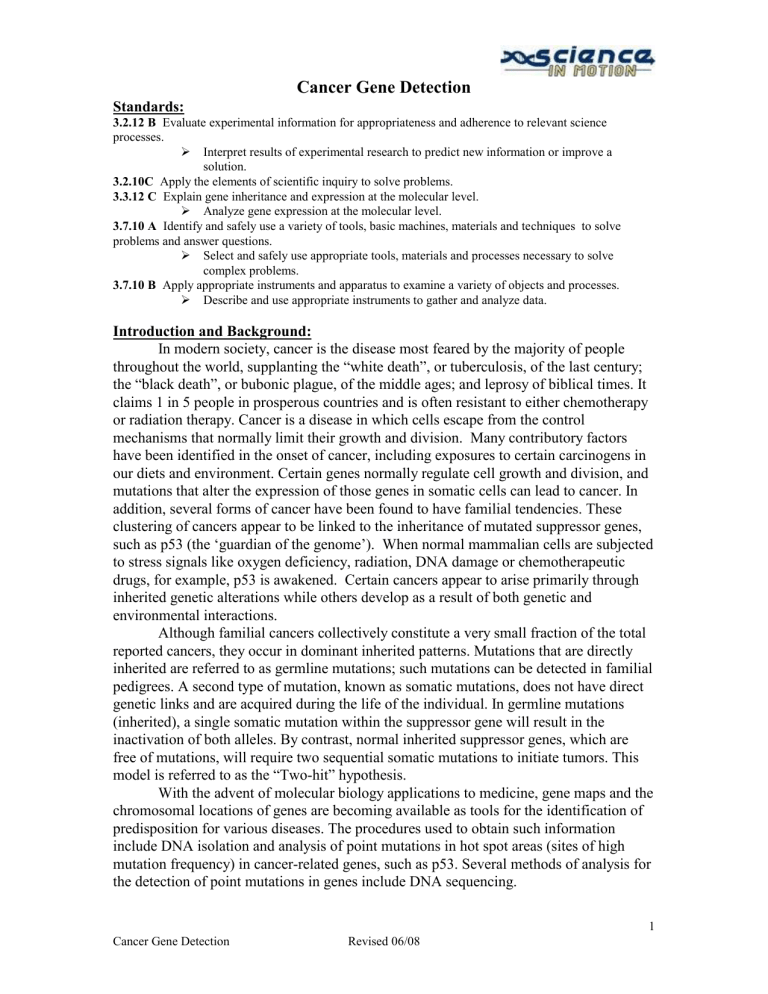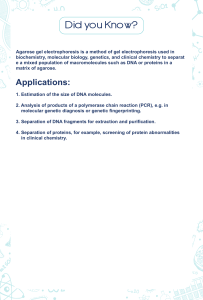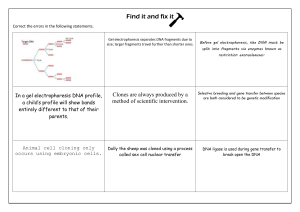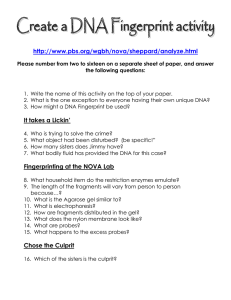
Cancer Gene Detection Standards: 3.2.12 B Evaluate experimental information for appropriateness and adherence to relevant science processes. Interpret results of experimental research to predict new information or improve a solution. 3.2.10C Apply the elements of scientific inquiry to solve problems. 3.3.12 C Explain gene inheritance and expression at the molecular level. Analyze gene expression at the molecular level. 3.7.10 A Identify and safely use a variety of tools, basic machines, materials and techniques to solve problems and answer questions. Select and safely use appropriate tools, materials and processes necessary to solve complex problems. 3.7.10 B Apply appropriate instruments and apparatus to examine a variety of objects and processes. Describe and use appropriate instruments to gather and analyze data. Introduction and Background: In modern society, cancer is the disease most feared by the majority of people throughout the world, supplanting the “white death”, or tuberculosis, of the last century; the “black death”, or bubonic plague, of the middle ages; and leprosy of biblical times. It claims 1 in 5 people in prosperous countries and is often resistant to either chemotherapy or radiation therapy. Cancer is a disease in which cells escape from the control mechanisms that normally limit their growth and division. Many contributory factors have been identified in the onset of cancer, including exposures to certain carcinogens in our diets and environment. Certain genes normally regulate cell growth and division, and mutations that alter the expression of those genes in somatic cells can lead to cancer. In addition, several forms of cancer have been found to have familial tendencies. These clustering of cancers appear to be linked to the inheritance of mutated suppressor genes, such as p53 (the ‘guardian of the genome’). When normal mammalian cells are subjected to stress signals like oxygen deficiency, radiation, DNA damage or chemotherapeutic drugs, for example, p53 is awakened. Certain cancers appear to arise primarily through inherited genetic alterations while others develop as a result of both genetic and environmental interactions. Although familial cancers collectively constitute a very small fraction of the total reported cancers, they occur in dominant inherited patterns. Mutations that are directly inherited are referred to as germline mutations; such mutations can be detected in familial pedigrees. A second type of mutation, known as somatic mutations, does not have direct genetic links and are acquired during the life of the individual. In germline mutations (inherited), a single somatic mutation within the suppressor gene will result in the inactivation of both alleles. By contrast, normal inherited suppressor genes, which are free of mutations, will require two sequential somatic mutations to initiate tumors. This model is referred to as the “Two-hit” hypothesis. With the advent of molecular biology applications to medicine, gene maps and the chromosomal locations of genes are becoming available as tools for the identification of predisposition for various diseases. The procedures used to obtain such information include DNA isolation and analysis of point mutations in hot spot areas (sites of high mutation frequency) in cancer-related genes, such as p53. Several methods of analysis for the detection of point mutations in genes include DNA sequencing. 1 Cancer Gene Detection Revised 06/08 Science In Motion Juniata College The genes that control the whole process of cancer are very complex and they do not act in isolation. At the molecular level, cancer formation is characterized by alterations in both dominant oncogenes and tumor suppressor genes, such as p53. Suppressors (“the brakes”) are normal cellular proteins that are involved in limiting cell growth. By contrast, oncogenes (“gas pedals”) are involved in promoting the growth of cells. Mutated suppressor genes may promote uncontrolled cell growth and therefore function as oncogenes. Historically, one of the first genes identified was Li-Fraumeni syndrome. In LiFraumeni syndrome (LFS) notable features in a family pedigree include a sarcoma patient and at least two immediate relatives with other cancers before the age of 45, as well as multiple cancers in other family members. Li-Fraumeni syndrome (LFS) is rare. When it does occur it affects young family members and results in high mortality rates. Cells in individuals with LFS have a single wild type p53 allele. Examination of the p53 has shown a correlation to mutation in the p53 protein. The mutant protein has the ability to bind to the normal p53 protein and inactivate it. Guiding Questions: Vocabulary: Materials: Day 1 Day 2 Day 3 microwave oven 3 power supplies camera and film hot water bath (37oC) Per lab group Per lab group Per lab group 1 agarose pour 1 comb electrophoresis gel tray 1 roll labeling tape micropipet micropipet tips aluminum foil food dye in micro-tubes plastic wrap or bags toothpicks 1 electrophoresis chamber 1 prepared gel (from Day 1) 1 micropipet micropipet tips TBE buffer micro-tube rack with DNA tubes: A - Standard DNA fragments B - Control DNA C - Patient Peripheral Blood DNA D - Patient Breast Tumor DNA E - Patient Breast Normal DNA staining tray methylene blue latex gloves distilled water light box Safety Notes: 1. 2. Follow correct aseptic technique procedures. Wear gloves and goggles during procedures. 2 Cancer Gene Detection Revised 06/08 Science In Motion Juniata College Construction of the Pedigree: The first step in the search and assignment of Li-Fraumeni syndrome is to establish the family pedigree of the patient. The information below has been gathered by the family physician and the oncologist. The pedigree that will be constructed is for a young woman who is suspected to have the Li-Fraumeni syndrome. Upon monthly breast self-examination, Sally Jones, age 36, found a small irregular mass. She was concerned because she knew that her mother had a mastectomy when she was in her late thirties. Sally made an appointment with her physician, who referred her to a specialist at a local cancer center, where she was diagnosed as having breast cancer. As a part of the medical work-up, the oncologist had inquired about her family history of cancer. Upon consultation with her mother, Sally learned that her father and his family appeared to be free of cancer. However, in Sally’s mother’s family, several cases of cancer have occurred. Given the following information, chart the family pedigree: - - Her mother, Joyce, was diagnosed and treated for breast cancer at the age of 39. Sally did not know that Joyce had a sister, Elaine, who died at age 2 of a brain tumor. Joyce’s brother, John underwent surgery, followed by chemotherapy for colon cancer. Sally’s maternal grandmother, Sophie, died at age 42 from bilateral breast cancer. Sally’s maternal grandfather, Len, was free of cancer and is 88 years old. Sally’s maternal cousin, Steve, (son of John), died of brain cancer at 14. Her cousin, Sue, aged 2 who is Steve’s sister, was diagnosed with childhood leukemia and subsequently died. Steve’s two other brothers, Bob, 28 and Kirk, 30, are in good health and free of cancer. Sally’s sister, Patty is free of cancer. Patty’s son, Mark was diagnosed at the age of 3 as having sarcoma. Recently, at the age of 18, he was diagnosed as having osteosarcoma. Patty’s other son, Lee, and daughter, Kim, are free of cancer. Sally has five children, all of whom show no signs of cancer at this time. She was interested in the p53 diagnostic test to determine if she inherited mutations. 3 Cancer Gene Detection Revised 06/08 Science In Motion Procedure - Day 1 Juniata College Making the Gels 1. Loosen the caps and heat the agarose pours in microwave. Make sure that all of the agarose is melted. 2. Carefully seal the ends of the tray with tape. If your seal leaks the agarose pour will be wasted. 3. Carefully align comb and place tray out of the way on the lab table so that when the hot agarose is poured it will not be disturbed. To assure proper well depth, place a dime in the bottom of the tray, adjusting the comb over it. (Adjust by turning the “headlights” on the comb so that it barely rests on the dime.) Remove the dime. 4. When agarose pours are still hot (but cool enough to touch) remove the cap and carefully pour hot agarose into taped tray. Make sure that your comb is aligned correctly. The agarose should cover 1/2 to 3/4 of the length of the teeth of the comb. Use a toothpick to remove any large bubbles of debris towards the end of the tray (away from comb). 5. Allow 10 – 15 minutes for the gel to solidify. Do not bump or disturb the tray during this time. 6. Practice using the micropipet while the gel is cooling. 7. If time permits, carefully remove the comb from the gel and cover tray with plastic wrap or place in plastic bag until tomorrow. Gels may be removed from the trays if the trays are needed for another class period. Be sure to label the plastic around your gel with your initials and class period. Procedure - Day 2 Loading and Running the Gels (This may continue from Day 1 if the class has a double period.) 1. Unwrap gel, place it in a tray if it is not already in one, and place it in the electrophoresis chamber. 2. Fill the electrophoresis chamber with TBE buffer (this can be reused) until it just covers the top surface of the gel. 3. Locate the labeled micro-tubes. Review the use of the micropipet. Using the micropipet, load 15 ul of each DNA sample into the wells of the gel. Use a different micropipet tip for each sample. 4. When the wells of the gel are loaded and oriented closest to the negative (-) or black electrode, you are ready to turn on the power supply. Set power at 70 volts and connect the electrodes – black-to-black, red-to-red. Slightly higher voltages may be used to speed up the process, but best separation occurs at lower voltages. Never go above 125 volts. 5. Record the time that you started. DNA fragments will be drawn toward the positive pole by the electricity. The progress of the DNA fragments can be followed by watching the loading dye in the DNA samples. It takes one and a half hours to run the gel. The process should be stopped when the DNA is about one half of an inch from the end of the gel. 6. Once finished running, the gel should be placed back in the plastic bag and refrigerated for use Day 3. 4 Cancer Gene Detection Revised 06/08 Science In Motion Procedure - Day 3 Juniata College Staining the Gels 1. Remove the gel from the plastic bag and carefully place it in the staining tray. Add enough methylene blue to just cover the gel. Stain the gel for a minimum of 30 minutes. Stir occasionally. 2. Destaining will be done twice in 600 ml of distilled water that has been warmed to 37oC. Water should not exceed this temperature! First destain – Place stained gel into 600 ml of 37oC distilled water for 15 minutes. Be sure the gel is completely submerged. Discard the destaining solution. Second destain - Place stained gel into another 600 ml of 37oC distilled water for 15 minutes. Be sure the gel is completely submerged. Discard the destaining solution. Bands will become clearly visible after the second destain. The gels may also be left to destain overnight. 3. Carefully remove the gel from the destaining solution and examine it on the light box. NOTE: If the bands are too light and are difficult to see, repeat the staining and destaining procedures. 4. Stained gels can be stored in plastic bags in the refrigerator for several weeks or discarded. Work Cited Bernstein, A. [online]. Gene Therapy & Cancer Treatment. http://www.bc.sympatico.ca/healthyway/HEALTHYWAY/interview_13.htm (1997) Campbell, N. Biology. 4th Ed. Benjamin/Cummings Publishing Company. Menlo Park, CA (1996) Edvotech, Inc. West Bethesda, MD (1998) Lane, D. Awakening angels. Nature394, 616-617 (1998) Woo, R. et. al. DNA-dependent protein kinase acts upstream of p53 in response to DNA damage. Nature394, 700-704 (1998) 5 Cancer Gene Detection Revised 06/08 Science In Motion Juniata College Cancer Gene Detection Evaluation Name __________________ 1. Place your pedigree below. Circles represent females and squares represent males. Shading indicates an individual with some form of cancer. For this lab, a shaded shape with a line through it indicates an individual that died of some form of cancer. L = wild type Li-Fraumeni syndrome (mutated p53 gene) and l = normal p53 gene. Label each individual with a genotype to illustrate the phenotype described. Use Punnett Squares to determine genotypes if needed. 2. Sketch your gel below, label it appropriately. 6 Cancer Gene Detection Revised 06/08 Science In Motion Juniata College 3. What can you infer about the health of Sally’s tumor from the gel results? 4. Why does Sally’s tumor DNA sample have fewer bands than the peripheral blood? 5. What is the purpose of the control lane? 6. Describe the function of p53 and what effect a mutation have on its effectiveness. 7. Hypothesize how a mutation in the p53 gene would arise. Using the process of transcription and translation, explain how a mutation decreases the effectiveness of the p53 protein. 7 Cancer Gene Detection Revised 06/08






